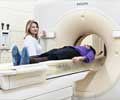An Australian study has said that CT scans generate up to one third more radiation than needed to yield a clear diagnostic image, thus exposing patients to an increased risk of cancer.
The findings have emerged amid concerns about the growth in referrals for CT scans and as radiation safety experts and radiologists prepare a national monitoring scheme to keep radiation doses to the minimum necessary.A pilot program aimed at optimising the radiation patients were exposed to in 10 Queensland hospitals found that radiation doses could be reduced by up to 32 per cent in a range of common CT scans while maintaining the quality of the diagnostic image.
A similar project is under way in Victoria and a national scheme is being developed to provide radiology practices with a "diagnostic reference level" to compare their radiation dose rates with other practices.
The use of CT (computed tomography) scans is growing at 9 per cent to 12 per cent a year in Australia.
Recently, the Medicare watchdog, Dr Tony Webber, said he was "alarmed" by the rate of unjustified referrals of patients for CT scans.
The Australian Radiation Protection and Nuclear Safety Agency (ARPANSA) is joining the Royal Australian and New Zealand College of Radiologists to undertake a national survey of radiation dose rates generated in Australia's diagnostic centres.
Advertisement
Associate Professor Stacy Goergen, a director of research in diagnostic imaging at Melbourne's Southern Health service, said that reducing radiation dose levels while maintaining good quality images was neither simple nor straightforward and required gradual and time-consuming adjustments to equipment.
Advertisement
"This results in a general dose-saving to the individual and a reduction in the public health risk of an expanding population of patients being imaged," the Age quoted Wallace as saying.
Source-ANI
RAS













